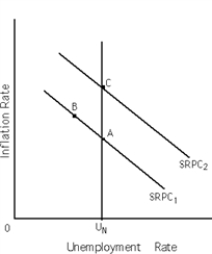Multiple Choice

-Refer to Exhibit 16-1.Suppose the economy is currently at point B on the short-run Phillips curve,SRPC1.What could get the economy to move to point C on SRPC2?
A) The realization on the part of workers that their currently held expected inflation rate is too high; they revise it upward,thus shifting the short-run aggregate supply curve rightward.
B) The realization on the part of workers that their currently held expected inflation rate is too high; they revise it downward,thus shifting the short-run aggregate supply curve rightward.
C) The realization on the part of workers that their currently held expected inflation rate is too low; they revise it upward,thus shifting the short-run aggregate supply curve leftward.
D) The realization on the part of workers that their currently held expected inflation rate is too low; they revise it downward,thus shifting the short-run aggregate supply curve rightward.
Correct Answer:

Verified
Correct Answer:
Verified
Q47: The policy ineffectiveness proposition (PIP)argument states that
Q48: An unanticipated decrease in aggregate demand will
Q49: <img src="https://d2lvgg3v3hfg70.cloudfront.net/TB6439/.jpg" alt=" -Refer to Exhibit
Q50: <img src="https://d2lvgg3v3hfg70.cloudfront.net/TB6439/.jpg" alt=" -Refer to Exhibit
Q51: <img src="https://d2lvgg3v3hfg70.cloudfront.net/TB6439/.jpg" alt=" -Refer to Exhibit
Q53: The original Phillips curve suggests a(n)_ relationship
Q54: Real business cycle theory emphasizes that an
Q55: Stagflation implies that<br>A) a tradeoff between inflation
Q56: An increase in the actual inflation rate
Q57: <img src="https://d2lvgg3v3hfg70.cloudfront.net/TB6439/.jpg" alt=" -Refer to Exhibit